Beginnings of the Holodeck: AMD's DX11 GPU, Eyefinity and 6 Display Outputs
by Anand Lal Shimpi on September 10, 2009 2:30 PM EST- Posted in
- GPUs
Wanna see what 24.5 million pixels looks like?

That's six Dell 30" displays, each with an individual resolution of 2560 x 1600. The game is World of Warcraft and the man crouched in front of the setup is Carrell Killebrew, his name may sound familiar.
Driving all of this is AMD's next-generation GPU, which will be announced later this month. I didn't leave out any letters, there's a single GPU driving all of these panels. The actual resolution being rendered at is 7680 x 3200; WoW got over 80 fps with the details maxed. This is the successor to the RV770. We can't talk specs but at today's AMD press conference two details are public: 2.15 billion transistors and over 2.5 TFLOPs of performance. As expected, but nice to know regardless.
The technology being demonstrated here is called Eyefinity and it actually all started in notebooks.
Not Multi-Monitor, but Single Large Surface
DisplayPort is gaining popularity. It's a very simple interface and you can expect to see mini-DisplayPort on notebooks and desktops alike in the very near future. Apple was the first to embrace it but others will follow.
The OEMs asked AMD for six possible outputs for DisplayPort from their notebook GPUs: up to two internally for notebook panels, up to two externally for conncetors on the side of the notebook and up to two for use via a docking station. In order to fulfill these needs AMD had to build in 6 lanes of DisplayPort outputs into its GPUs, driven by a single display engine. A single display engine could drive any two outputs, similar to how graphics cards work today.
Eventually someone looked at all of the outputs and realized that without too much effort you could drive six displays off of a single card - you just needed more display engines on the chip. AMD's DX11 GPU family does just that.
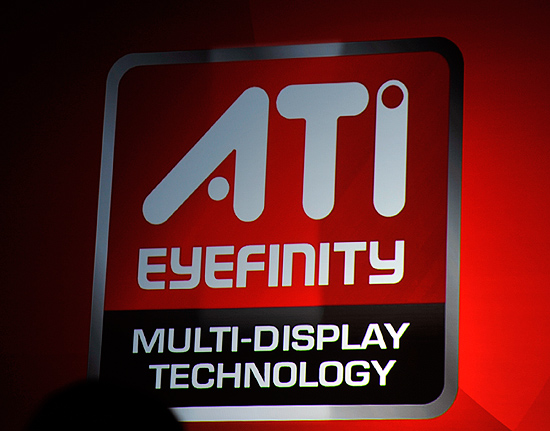
At the bare minimum, the lowest end AMD DX11 GPU can support up to 3 displays. At the high end? A single GPU will be able to drive up to 6 displays.

AMD's software makes the displays appear as one. This will work in Vista, Windows 7 as well as Linux.
The software layer makes it all seamless. The displays appear independent until you turn on SLS mode (Single Large Surface). When on, they'll appear to Windows and its applications as one large, high resolution display. There's no multimonitor mess to deal with, it just works. This is the way to do multi-monitor, both for work and games.
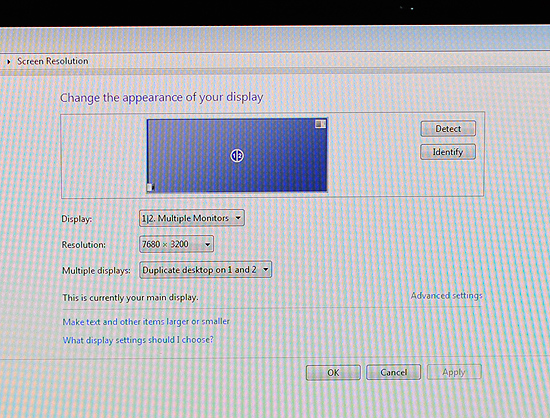
Note the desktop resolution of the 3x2 display setup
I played Dirt 2, a DX11 title at 7680 x 3200 and saw definitely playable frame rates. I played Left 4 Dead and the experience was much better. Obviously this new GPU is powerful, although I wouldn't expect it to run everything at super high frame rates at 7680 x 3200.
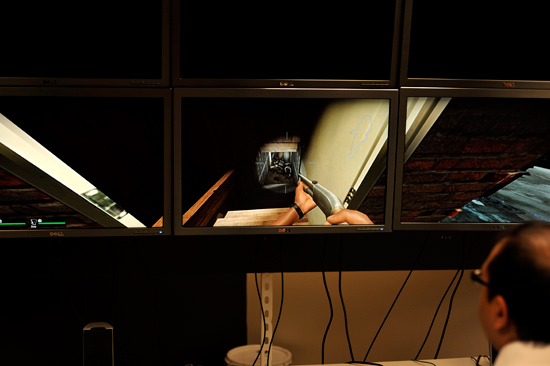
Left 4 Dead in a 3 monitor configuration, 7680 x 1600
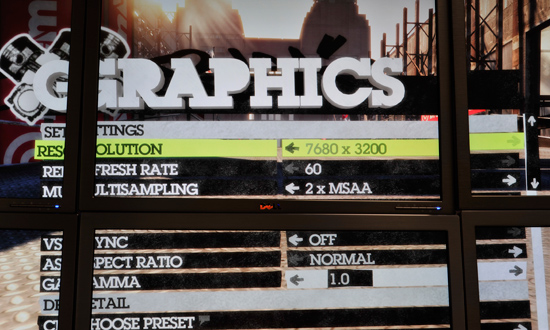
If a game pulls its resolution list from Windows, it'll work perfectly with Eyefinity.
With six 30" panels you're looking at several thousand dollars worth of displays. That was never the ultimate intention of Eyefinity, despite its overwhelming sweetness. Instead the idea was to provide gamers (and others in need of a single, high resolution display) the ability to piece together a display that offered more resolution and was more immersive than anything on the market today. The idea isn't to pick up six 30" displays but perhaps add a third 20" panel to your existing setup, or buy five $150 displays to build the ultimate gaming setup. Even using 1680 x 1050 displays in a 5x1 arrangement (ideal for first person shooters apparently, since you get a nice wrap around effect) still nets you a 8400 x 1050 display. If you want more vertical real estate, switch over to a 3x2 setup and then you're at 5040 x 2100. That's more resolution for less than most high end 30" panels.
![]()
Any configuration is supported, you can even group displays together. So you could turn a set of six displays into a group of 4 and a group of 2.
It all just seems to work, which is arguably the most impressive part of it all. AMD has partnered up with at least one display manufacturer to sell displays with thinner bezels and without distracting LEDs on the front:
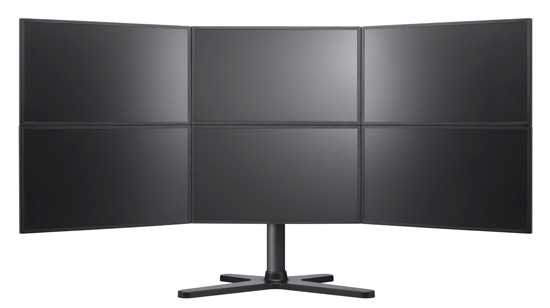
A render of what the Samsung Eyefinity optimized displays will look like
We can expect brackets and support from more monitor makers in the future. Building a wall of displays isn't exactly easy.










137 Comments
View All Comments
Anubis - Friday, September 11, 2009 - link
lol no it cant
zebrax2 - Thursday, September 10, 2009 - link
Well he did say that he played dirt 2 with playable frame ratesaraczynski - Thursday, September 10, 2009 - link
good to see the hardware manufacturers bastardizing moore's law. not only does the technology double in power every 18 months (or whatever), it also suspiciously doubles in price at the same time! well, at least on the new tech to take up the slack for the price halving of the old tech.know of fence - Thursday, September 10, 2009 - link
There is a sweetspot for pixel density (~100 dpi) and minimal viewing distance (~20 inches). More Pixels and bigger screens just means bigger minimal distance from the screen.Unless there are concerns with myopia, big but distant screens don't make much sense for reading or playing. (People beyond 35 tend to pull up and "hug" their monitors anyway.)
Bigger resolutions are interesting for advertisers who don't want their walls of flickering commercials appear blurry when approached.
Also 10 and more megapixels would make it possible to show photographs in native resolution.
There is no point of rendering a plain on a surrounding monitor setup, but rendering a long horizon with 3 monitors could be quite immersive indeed.
A setup of six 16:10 monitors has practically cinemascope aspect ratio 1:2,4. Six 200$ monitors could create a brighter alternative to the projector home cinema experience.
RubberJohnny - Friday, September 11, 2009 - link
"A setup of six 16:10 monitors has practically cinemascope aspect ratio 1:2,4. Six 200$ monitors could create a brighter alternative to the projector home cinema experience"No thanks, i'd take a single 1080p projector over 6 monitors. Whats the point of all that res if you have distracting black bars running through it? LCD manufacturers could make super large, super high res displays right now...if there was demand.
Randomblame - Thursday, September 10, 2009 - link
and I thought my WoW experiance improved when I went to my 24in 1080p monitor now I feel shamed. I must have this....EJ257 - Thursday, September 10, 2009 - link
How about flight sim and motor racing games? This GPU coupled with a curved/wrap-around 100" LCD. How about a 4 GPU "personal supercomputer" setup like the Tesla? =)stevejg61 - Thursday, September 10, 2009 - link
There is one inherent problem that needs to be addressed with the curved, wrap around. It has to have several FOVs, one for each monitor. We ran into this using the Evans & Sutherlin Laser Projector (5Kx4K and 8Kx4K - yes those were real resolutions using 16 PCs). Generally video game will use a single FOV, whereas you would need one for each monitor in reality. The other way is to get distortion correction working for the whole picture, but that involves rendering in an area bigger than the displayed resolution and also doing it on the fly, which will induce a frame lag in rendering.james jwb - Thursday, September 10, 2009 - link
those who've been keeping an eye on Matrox triplehead2go are going to be drooling at this. This is easily the right way to do this.What is the b/w limit of this system, does it have 6 display port's b/w?
drmo - Thursday, September 10, 2009 - link
I would just like to see an FPS that shows you what you would see with peripheral vision. Then I could see the point in having a three monitor setup for games. In real life, I can tell when someone is right beside me, but in an FPS, I can't unless I turn that way. Just having a wider view of what is in front of me doesn't do anything for me.